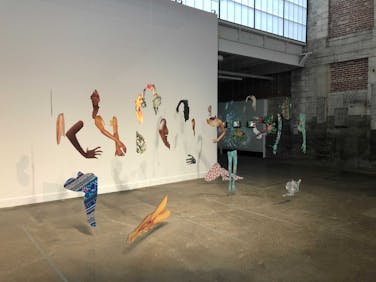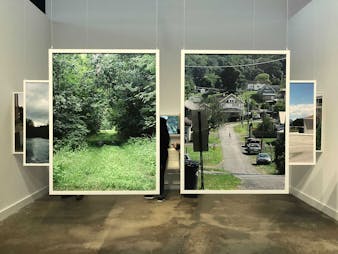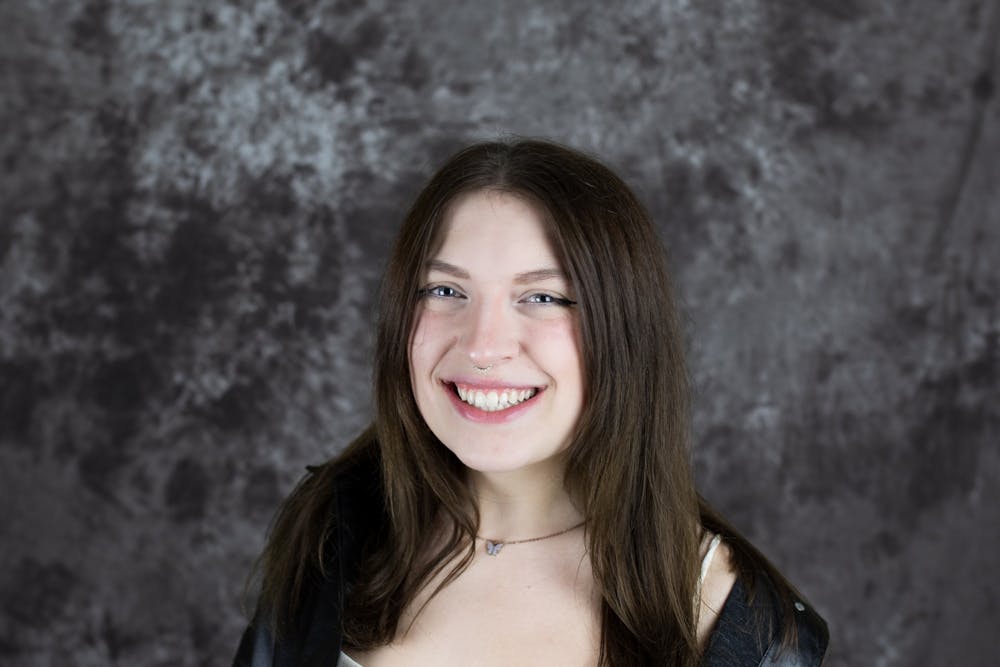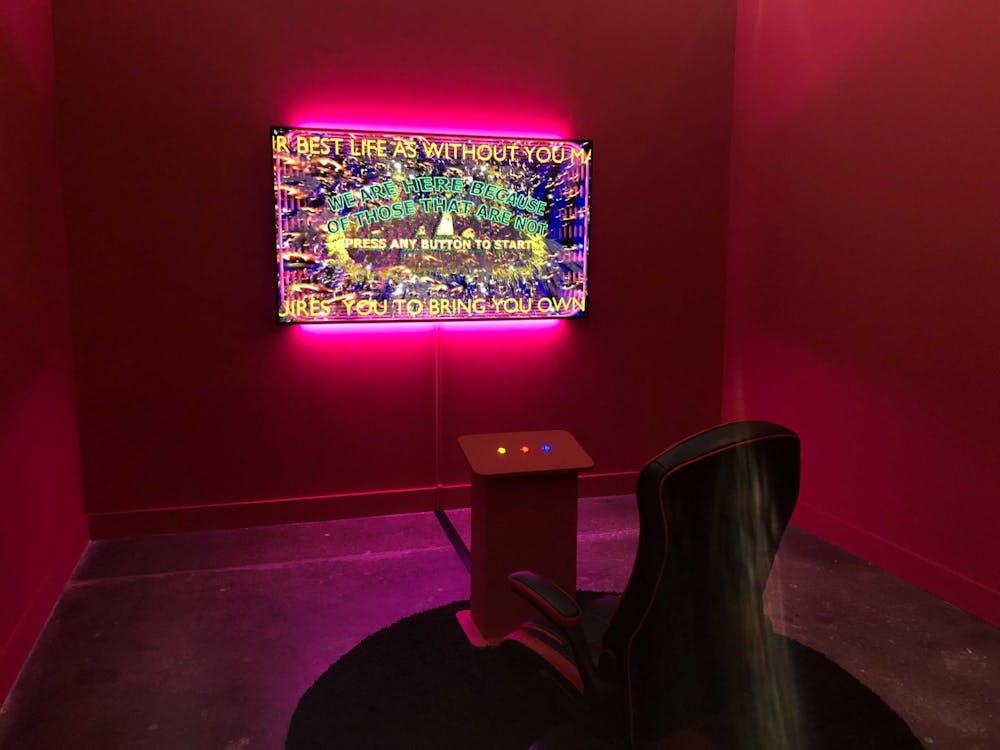There’s a room with hot pink walls. It’s secluded from the noise of the crowd, naked except for a black gaming chair, a pedestal fixed with primary colored buttons and a TV screen exploding in kaleidoscope-esque designs.
You sit in the chair, the TV looming above you, pink fluorescent lights humming. The screen says to press any button to start.
You do.
For the next 20 minutes, you are launched into a haunting adventure game regarding Black trans identity, ancestry and allyship.
Except, this isn’t only a visceral video game. It’s Danielle Brathwaite-Shirley’s art installation, “WE ARE HERE BECAUSE OF THOSE THAT ARE NOT,” now a part of Albright-Knox Northland’s newest exhibition, “Difference Machines: Technology and Identity in Contemporary Art.”
The art exhibit, co-curated by UB art professor Paul Vanouse and assistant curator Tina Rivers Ryan, features 17 artists whose interactive works explore the manner in which technology shapes our lives, from the exploration of identity through digital tools to the examination of surveillance. The free exhibit opened Oct. 16 and will run through Jan. 16, 2022.
Vanouse and Ryan intended to create a space where people can hone their grasp on the ways in which technology interacts with themselves and the world.
“You can think of this [show] as being somewhere between a regular exhibition, a film festival and a library,” Vanouse said.
Yet, despite this daunting description as a hybrid center of artistic creation, Ryan and Vanhouse placed a focus on making the space accessible to newcomers.
“We wanted to create an exhibition where people who don’t have that technical expertise or knowledge could come in and learn something about the technologies that are governing literally every aspect of our lives,” Ryan said.
Similarly, Vanouse also emphasized how identity shapes this space and learning process.
“Everything kind of kept coming back to this question of identity and how digital tools inform identities,” Vanouse said. “In some ways they construct them, in some ways limit them.”
Many visitors cited Hasan Elahi’s “Tracking Transience” as a particularly thought-provoking piece, in terms of mistaken identity and technology as a tool for surveillance.
This installation, which arose after the FBI erroneously investigated Elahi for terrorist activity following the 9/11 attacks, is one of the first to greet visitors’ eyes when entering the exhibition.
“There’s something about surveillance that complicates identity and reflects how we live,” UB theatre and dance professor Lindsay Brandon Hunter said.
With rainbow photographs stretching to the ceiling and across the floor, “Tracking Transience” reuses photos Elahi took of his everyday life, including that of the toilet and foods he ate. Elahi took these photos to allow his FBI agent to better monitor his activities.

Joiri Minaya’s “#dominicanwomengooglesearch” features cutouts of body parts.
“I liked that as a statement,” Anita Miosi, a former UB secretary, said. “It’s a kind of blending an art and political statement.”
Visitors have also reflected on the manner in which the actual building, a former car manufacturing plant, augmented the experience of viewing Elahi’s work.
“You don’t go into galleries and see exposed brick walls,” Edreys Wajed, an MFA candidate in fine art, said. “So being that the brick wall is exposed, it presents a different opportunity for artwork to be powerful at the actual structure.”
Beyond Elahi’s installation, visitors felt that multiple artworks spoke greatly to matters of race and other forms of marginalized identities.
For freshman accounting major Cameron Osborne, Mongrel’s “Heritage Gold” stood out in particular.
“I thought it was pretty cool,” Obsarne said. “I feel like people hold on to their identity too much, their racial identity. And I feel like as a society we can’t move forward without just being ourselves.”
“Heritage Gold” features a vintage CRT (cathode-ray tube) monitor and manipulates Photoshop to allow users to filter photographed people by making changes to class, race, social status and more.
Although unable to cite a particular installation, Howard Lisker, a visitor to the exhibit, saw the Difference Machines exhibit as creating a conversation around contemporary social justice movements.
“In some way it interacts, for me, more strongly with Black Lives Matter,” Lisker said. “It’s this sort of continuous awakening in the non-Black world to the pervasiveness of discrimination and marginalization.”
As visitors made their way through the sprawling space, conversations echoed across the exhibit, particularly addressing its relationship to COVID-19.
“It’s refreshing to see work that has been made and generated prior to the pandemic,” Jared Mezzocchi, a visitor to the exhibit, said. “We don’t need to associate the pandemic with the explosion of technology. It’s been exploding since the early aughts.”
Harkening on the history of technological integration in our lives, the exhibit also creates an in-person space for art, which has largely been inaccessible in the past year due to COVID-19 restrictions.
“We wanted to offer people a different kind of experience than what they’ve been having during COVID-19,” Ryan said. “You’ve been sort of looking at your screen, but it’s been very private.”
For Alexa Wajed, who attended the event, the show did just this, giving her a social and public environment to roam around in.
“Face to face things like networking, meeting people — it’s like the space is perfectly designed for that,” Alexa Wajed said.

Sean Fader’s “Insufficient Memory” maps LGBTQ murders in the U.S.
Edreys Wajed, who attended the event, also celebrated the ability to view art offline, in opposition to Ryan’s concern that visitors would have “screen fatigue.”
“Technology has become such a part of our daily lives as of late,” Wajed said. “So when you see technology in a space like this, in an art gallery space, this allows you to remove yourself from the technology, because now you’re observing. You’re not necessarily scrolling [through] your phone and things of that nature.”
As for Vanouse, the ability to simply partake in the exhibit represents a silver-lining during a time of restricted access to in-person events.
“This show has been a kind of lifeline for me, emotionally,” Vanouse said. “My artwork is very complicated to install and set up, so all of my solo shows, or all of my shows, are canceled this year.”
Overall, “Difference Machines” serves to garner a space of intense emotional response while pushing visitors to meditate on the ways technology informs their lives, from racial and queer identities to issues of privacy and surveillance.
“It’s not just to capture the world we live in,” Mezzocchi said. “It creates dialogue around how we use technology to be more conscious.”
Kara Anderson is the assistant arts editor and can be reached at kara.anderson@ubspectrum.com

Kara Anderson is a senior arts editor at The Spectrum. She is an English and Spanish double major and is pursuing a certificate in creative writing. She enjoys baking chocolate chip cookies, procrastinating with solitaire and binging reality TV on the weekends.





